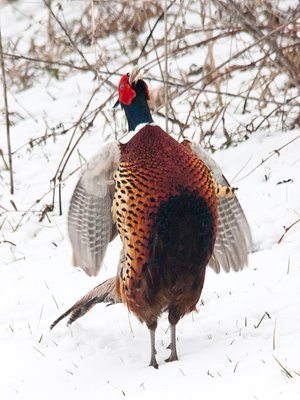
Revitalizing Minnesota’s pheasant hunting tradition and improving pheasant habitat are goals of a four-year Pheasant Summit Action Plan resulting from the Minnesota Pheasant Summit convened by Gov. Mark Dayton in 2014. The Action Plan was outlined and introduced by Governor Dayton during a September 14 press conference in Nicollet, Minn.
“For 60 years, I have enjoyed pheasant hunting in Minnesota,” said Governor Dayton. “The decisions we make today will determine whether future generations of Minnesotans will have those same opportunities. We must work together to increase the pheasant population in our state.”
The pheasant action plan outlines ten immediate and achievable steps that will make the greatest difference in improving pheasant habitat, pheasant numbers and hunting opportunities, and includes development of an annual report card to track progress over time.
“Governor Dayton showed bold leadership at the Pheasant Summit and invited Minnesotans to share their ideas for reversing declines in pheasants and pheasant hunters,” said Department of Natural Resources Commissioner Tom Landwehr. “For the pheasant action plan to succeed, we will need collaboration across agencies, with the Legislature, and with conservation organizations, farmers and landowners.”
Some of the actions outlined in the plan already are underway. The Legislature passed last session buffer legislation that establishes vegetation buffers along rivers, streams and ditches that will help filter out phosphorus, nitrogen and sediment. Just last month, the DNR received a $1.7 million grant for the Walk-In Access program from the Natural Resources Conservation Service. Additionally, conservation partners submitted 13 proposals to the Lessard-Sams Outdoor Heritage Council totaling $128 million for grassland habitat protection and management.
Ten Steps to Improve Hunting and Habitat
The plan grew out of ideas generated by citizens at last year’s pheasant summit. A steering committee comprised of DNR, Minnesota Department of Agriculture, Board of Water and Soil Resources, Minnesota Association of Soil and Water Conservation Districts, Pheasants Forever, Minnesota Farmers Union, Minnesota Farm Bureau Federation and Hunting Works organized and fine-tuned the ideas into 10 achievable action items:
- Enhance and protect habitat in areas at least 9 square miles large where at least 40 percent of the area can be permanently protected within four years.
- Increase the rate of enrollment and retention in short-term conservation programs and enrollment of permanent conservation easements by private landowners.
- Increase education and marketing of private lands conservation programs through the Farm Bill Assistance Partnership.
- Increase management of habitat on both public and private lands.
- Accelerate acquisition of land to increase the amount of public land open to hunting across the state’s pheasant range.
- Develop and implement a comprehensive riparian buffer program.
- Improve roadside management to optimize pheasant habitat.
- Secure federal funding to sustain the Walk-In Access program in the pheasant range.
- Expand public education about grassland and pheasant conservation issues and support hunter recruitment and retention.
- Expand monitoring and research capacity for both habitat and population studies of grassland wildlife and clearly communicate these results to the public.
The complete plan is available on the DNR website at
www.mndnr.gov/pheasantsummit.
“Farmers and landowners are central to helping us increase pheasant populations in Minnesota,” said Agriculture Commissioner David Frederickson. “ Through engagement with key stakeholder groups, including farmers, this plan was developed that outlines steps we can take to enhance pheasant numbers. I urge all farmers and landowners to review the plan and to consider how you can do your part to help us boost the pheasant population in our state.”
Increasing private land conservation is a key component of the Pheasant Summit Action Plan, said John Jaschke, BWSR executive director.
“We have the programs in place to make the plan a reality, and look forward to accelerating our work with DNR, Pheasants Forever, other conservation partners, and landowners to provide permanent habitat protection on private lands through the Re-Invest in Minnesota Reserve program,” said Board of Water and Soil Resources executive director John Jaschke.
Habitat Loss Drives Population Trend
Habitat drives the long-term trend in the pheasant population, and loss of grassland habitat has caused a decline in populations of pheasants and other grassland wildlife. This has led to a parallel decline in the number of pheasant hunters and the quality of the hunting experience.
The 2015 Minnesota pheasant index is 39 percent below the 10-year average and 59 percent below the long-term average. Although this year’s August roadside survey by the DNR showed a 33 percent increase in the number of Minnesota pheasants compared to last year at this time, the increase was mainly due to favorable weather conditions.
The loss of nesting habitat, driven by the expiration of Conservation Reserve Program (CRP) acres, is the primary reason there has been a steady decline in Minnesota’s pheasant harvest since the mid-2000s. Minnesota has lost 153,492 acres of CRP since last year and greater than 247,000 acres of CRP since 2007. Many more acres – likely more than 495,000 acres – could expire by 2018 if contracts are not renewed or new acres are not enrolled into the program.
Since the Pheasant Summit, the DNR has been actively engaged in grassland conservation and progress has been made that will continue as more of the steps outlined in the action plan are achieved.
For details and a digital copy of the Pheasant Summit Action Plan, visit the DNR website at
www.mndnr.gov/pheasantsummit.
Photo Credit: Carrol Henderson, Minnesota DNR
Media Contact
Jared Wiklund
(651) 209-4953
jwiklund@pheasantsforever.org